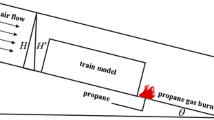Abstract
Research on the distribution of smoke in tunnels is significant for the fire emergency rescue after an operating metro train catches fire. A dynamic grid technique was adopted to research the law of smoke flow diffusion inside the tunnel when the bottom of a metro train was on fire and to compare the effect of longitudinal ventilation modes on the smoke motion when the burning train stopped. Research results show that the slipstream curves around the train obtained by numerical simulation are consistent with experimental data. When the train decelerates, the smoke flow first extends to the tail of the train. With the decrease of the train’s speed, the smoke flow diffuses to the head of the train. After the train stops, the slipstream around the train formed in the process of train operation plays a leading role in the smoke diffusion in the tunnel. The smoke flow quickly diffuses to the domain in front of the train. After forward mechanical ventilation is provided, the smoke flow inside the tunnel continues to diffuse downstream. When reverse mechanical ventilation operates, the smoke in front of the train flows back rapidly and diffuses to the rear of the train.
Similar content being viewed by others
References
ALAN N B. Tunnel safety, risk assessment and decision-making [J]. Tunnelling and Underground Space Technology, 2010, 25(1): 91–94.
CAMILLO A, GUILLAUME E, ROGAUME T, ALLARD A, DIDIEUX F. Risk analysis of fire and evacuation events in the European railway transport network [J]. Fire Safety Journal, 2013, 60(4): 25–36.
ALAN N B. Fire safety in tunnels [J]. Fire Safety Journal, 2009, 44(2): 276–278.
YANG Gao-shang, PENG Li-min, ZHANG Jin-hua, AN Yong-lin. Simulation of people’s evacuation in tunnel fire [J]. Journal of Central South University of Technology, 2006, 13(3): 307–312.
JIANG Xue-peng, HU Jie, XU Zhi-sheng, ZHAO Hong-li, LIU Qi. Computation model for back-layering flow of fire smoke in railway tunnel [J]. Journal of Central South University (Science and Technology), 2011, 42(9): 2837–2842. (in Chinese)
MENG Na, HU Long-hua, WU Long, YANG Li-zhong, ZHU Shi, CHEN Long-fei, TANG Wei. Numerical study on the optimization of smoke ventilation mode at the conjunction area between tunnel track and platform in emergency of a train fire at subway station [J]. Tunnelling and Underground Space Technology, 2014, 40(1): 151–159.
AHMED K, YUAN Zhong-yuan, LEI Bo. Ceiling temperature distribution and smoke diffusion in tunnel fires with natural ventilation [J]. Fire Safety Journal, 2013, 62(11): 249–255.
ENRICO R. Testing the predictive capabilities of evacuation models for tunnel fire safety analysis [J]. Safety Science, 2013, 59(11): 141–153.
OLENICK S M, CARPENTER D J. An international survey of computer models for fire and smoke [J]. Journal of Fire Protection Engineering, 2003, 13(5): 87–110.
JURAEVA M, LEE J, SONG D J. A computational analysis of the train-wind to identify the best position for the air-curtain installation [J]. Journal of Wind Engineering and Industrial Aerodynamics, 2011, 99(5): 554–559.
XU Zhi-sheng, ZHAO Hong-li, LI Hong, JIANG Xue-peng, LI Dong. Theoretical model of critical wind velocity in horizontal tunnel fires [J]. Journal of Central South University (Science and Technology), 2013, 44(3): 1138–1143. (in Chinese)
MASHIMO H. State of the tunnel safety technology in Japan [J]. Tunnelling and Underground Space Technology, 2002, 17(2): 145–152.
QU Lu. Theoretic analysis and experiment study of burning characteristic and safety of moving train in subway fire [D]. Beijing: Beijing University of Technology, 2011. (in Chinese)
XU Zhi-sheng, ZHOU Qing, XU Yu. Fire model experiment and numerical simulation of passenger trains running in tunnels [J]. Journal of the China Railway Society, 2004, 26(1): 124–128. (in Chinese)
LI Xiang-lei. Research on the fire characteristic of moving subway train [D]. Beijing: The Northern Transportation University, 2011. (in Chinese)
XIE Xiong-yao, DING Liang-ping, LI Yong-sheng. CFD simulation on evacuation of a high-speed train continue-roll during long tunnel fires [J]. Journal of Tongji University (Natural Science), 2010, 38(12): 1746–1752. (in Chinese)
MARTA L G, MÓNICA G V, JESÚS M F O, EDUARDO B M. Numerical modeling of the piston effect in longitudinal ventilation systems for subway tunnels [J]. Tunnelling and Underground Space Technology, 2014, 40(2): 22–37.
JAE S R, HONG S R, WON H P, YONG J J. CFD simulation and assessment of life safety in a subway train fire [J]. Tunnelling and Underground Space Technology, 2009, 24(4): 447–453.
Author information
Authors and Affiliations
Corresponding author
Additional information
Foundation item: Project(U1134203) supported by the Major Program of the National Natural Science Foundation of China; Project(51105384) supported by the National Natural Science Foundation of China
Rights and permissions
About this article
Cite this article
Zhou, D., Tian, Hq., Zheng, Jl. et al. Smoke movement in a tunnel of a running metro train on fire. J. Cent. South Univ. 22, 208–213 (2015). https://doi.org/10.1007/s11771-015-2511-0
Received:
Accepted:
Published:
Issue Date:
DOI: https://doi.org/10.1007/s11771-015-2511-0




